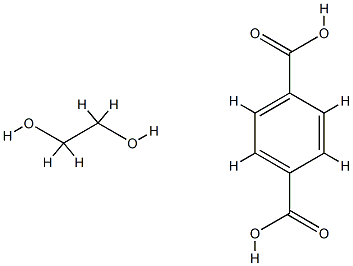Polyethylene terephthalate (PET) is a saturated thermoplastic polyester. The first PET fibers, DacronTM and TeryleneTM, were first developed by Whinfield and Dixon in England. The first DacronTM plant began production in 1953. PET is produced using direct polycondensation reaction with ethylene glycol and terephthalic acid.lt is widely used in synthetic fibers which simulate wool, cotton, or rayon. PET films MylarTM, MelinexTM) are biaxially oriented by cold stretching the extruded sheets in two directions. This increases the crystallinity and reduces the tendency to shrink when heated. PET films are used in capacitors,slot liners for motors,magnetic tape, x-ray film, photographic film, graphic art and drafting applications,and food packaging such as boil-in-bags.
The first stage to produce Polyethylene Terephthalate (PET) is the reaction of ethylene glycol with terephthalic acid or dimethyl terephthalate. After the initial reaction, two or three polymerization steps are then performed, depending on the required molecular weight. The chemical structure of PET is composed of repeated units. Each unit has a physical length of about 1.09 nm and a molecular weight of ~200. PET monomer consists from an aromatic ring coupled with a short aliphatic chain that makes PET a stiff molecule as compared to other aliphatic polymers such as polyolefin or polyamide. The lack of segmental mobility in the polymer chains results in relatively high thermal stability. A textile grade polymer will have an average number of 100 repeat units per molecule so that the extended length of the typical polymer chain is about 100 nm with a molecular weight of ~20,000. Higher levels of polymerization produce higher strength fibers but the melt viscosity and stability of the melt to even tiny amounts of moisture causes hydrolytic degradation.
Photo-degradation of PET occurs after exposure to near-ultraviolet light resulting in either chain scission by Norrish I and II reactions. Cross-linking also takes place and polymer becomes brittle, discolored, and with uneven surface. PET when exposed to UV light degrades rather rapidly leading to deterioration in physical and mechanical properties and develops intense yellow color. It has been suggested that the photo-oxidation of PET involves the formation of hydroperoxide species through oxidation of the CH2 groups adjacent to the ester linkages and the hydroperoxide species involving the formation of photoproducts through several pathways. The ester moieties in the terephthalate moiety as well as CH2 groups are strongly involved in the photo-degradation of PET. The vinyl ester ends also act as cross-linkers and gelling agents. They polymerize and the polymers thermally degrade to give yellow or brown polyenes that discolor the final polymer. The formation of highly conjugated species is catalyzed by carboxyl groups. The formation of colored species is followed by increase of more carboxyl terminated species. Hence, the product having higher carboxyl value is subject to more discoloration. Furthermore, as the carboxyl content increases, the thermo-oxidative stability decreases. The carboxyl end groups act as catalysts for further degradation.






